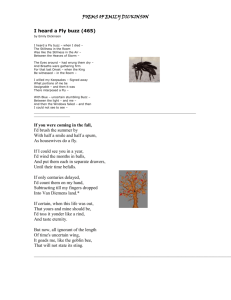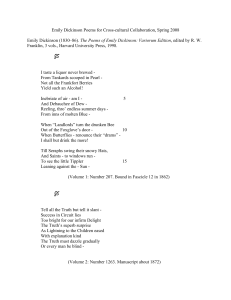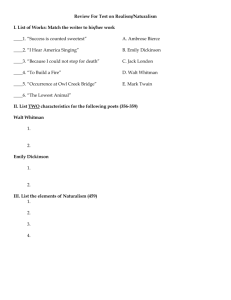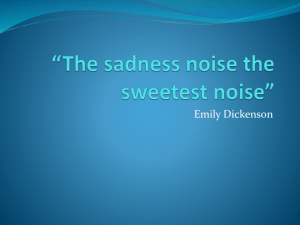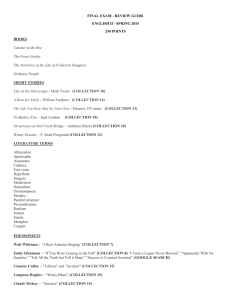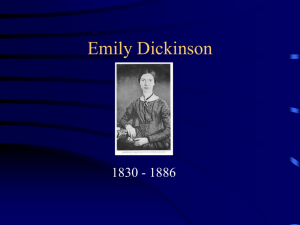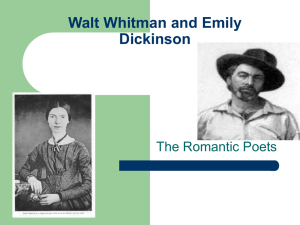WEEK 8
advertisement
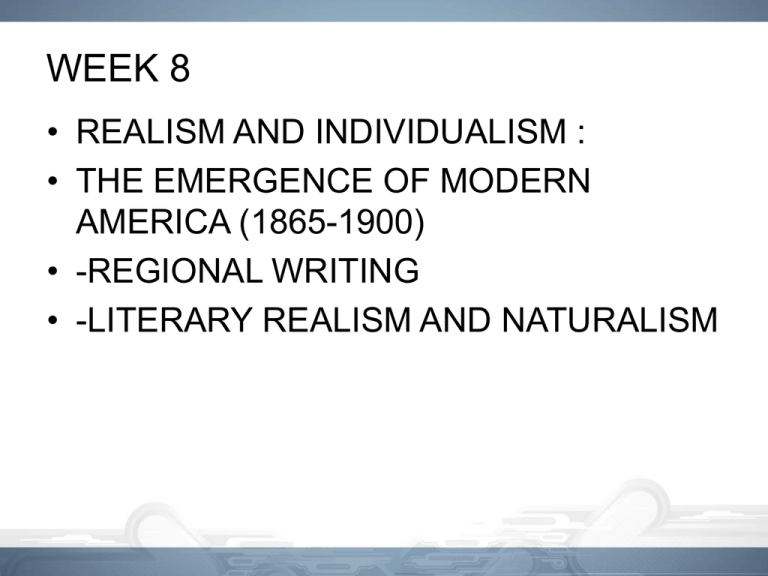
WEEK 8 • REALISM AND INDIVIDUALISM : • THE EMERGENCE OF MODERN AMERICA (1865-1900) • -REGIONAL WRITING • -LITERARY REALISM AND NATURALISM CIVIL WAR CIVIL WAR The Civil War is the central event in America's historical consciousness. While the Revolution of 1776-1783 created the United States, the Civil War of 1861-1865 determined what kind of nation it would be. The war resolved two fundamental questions left unresolved by the revolution: whether the United States was to be a dissolvable confederation of sovereign states or an indivisible nation with a sovereign national government; and whether this nation, born of a declaration that all men were created with an equal right to liberty, would continue to exist as the largest slaveholding country in the world. Northern victory in the war preserved the United States as one nation and ended the institution of slavery that had divided the country from its beginning. But these achievements came at the cost of 625,000 lives-nearly as many American soldiers as died in all the other wars in which this country has fought combined. The American Civil War was the largest and most destructive conflict in the Western world between the end of the Napoleonic Wars in 1815 and the onset of World War I in 1914. The Civil War started because of uncompromising differences between the free and slave states over the power of the national government to prohibit slavery in the territories that had not yet become states. When Abraham Lincoln won election in 1860 as the first Republican president on a platform pledging to keep slavery out of the territories, seven slave states in the deep South seceded and formed a new nation, the Confederate States of America. The event that triggered war came at Fort Sumter in Charleston Bay on April 12, 1861. Claiming this United States fort as their own, the Confederate army on that day opened fire on the federal garrison and forced it to lower the American flag in surrender. Lincoln called out the militia to suppress this "insurrection." Four more slave states seceded and joined the Confederacy. By the spring of 1865 all the principal Confederate armies surrendered, and when Union cavalry captured the fleeing Confederate President Jefferson Davis in Georgia on May 10, 1865, resistance collapsed and the war ended. The long, painful process of rebuilding a united nation free of slavery began. REALISM (1860s – 1890s) • life presented with fidelity • fidelity in presenting the inner workings of the mind • the analysis of thought and feeling • function of environment in shaping the character • set in present or recent past • commonplace characters • exposed political corruption, economic inequity, business deception, the exploitation of labor, women rights problems, racial inequity • described the relationship between the economic transformation of America and its moral condition Why did Realism develop? • • • • • • The Civil War The urbanization and industrialization of America As a reaction to Romanticism Increasing rates of democracy and literacy The emerging middle class Upheaval and social change in the latter half of the 19th century What is Realism? • A faithful representation of reality in literature, also known as “verisimilitude.” • Emphasis on development of believable characters. • Written in natural vernacular, or dialect. • Prominent from 1860-1890. Characteristics of Realism • Reaction against Romanticism and Neoclassicism • Factual is more important than the intellectual or the emotional • Treats nature objectively, but views it as orderly • Tells the stories of everyday people • Use of details more important than plot • In diction, seeks to use natural language • Atheistic • Life is driven by fate Realist Writers Mark Twain William Dean Howells Henry James Edgar Lee Masters Sarah Orne Jewett REALISM MARK TWAIN Born on November 30, 1835, in Florida, Missouri, Samuel L. Clemens wrote under the pen name Mark Twain and went on to pen several novels, including two major classics of American literature, The Adventures of Tom Sawyer and Adventures of Huckleberry Finn. He was also a riverboat pilot, journalist, lecturer, entrepreneur and inventor. Twain died on April 21, 1910, in Redding, Connecticut. Mark Twain can be seen as a Regional Writer and a Realist Writer. His popularity sky-rocketed with the publications of The Adventures of Tom Sawyer (1876), The Prince and the Pauper (1882), and The Adventures of Huckleberry Finn (1885). By 1885, Twain was considered one the greatest character writers in the literary community. Biography of Sarah Orne Jewett Sarah Orne Jewett (September 3, 1849 – June 24, 1909) was an American novelist and short story writer, best known for her local color works set in or near South Berwick, Maine, on the border of New Hampshire, which in her day was a declining New England seaport. Jewett possessed a keen descriptive gift that William Dean Howells called "an uncommon feeling for talk — I hear your people." Jewett made her reputation with the novella The Country of the Pointed Firs (1896). A Country Doctor (1884), a novel reflecting her father and her early ambitions for a medical career, and A White Heron (1886), a collection of short stories are among her finest work. Some of Jewett's poetry was collected in Verses (1916), and she also wrote three children's books. Willa Cather described Jewett as a significant influence on her development as a writer, and "feminist critics have since championed her writing for its rich account of women's lives and voices." Jewett never married; but she established a close friendship with writer Annie Fields (1834-1915) and her husband, publisher James Thomas Fields, editor of the Atlantic Monthly. After the sudden death of James Fields in 1881, Jewett and Annie Fields lived together for the rest of Jewett's life in what was then termed a "Boston marriage.“ Some modern scholars have speculated that the two were lovers. In any case, "the two women found friendship, humor, and literary encouragement" in one another's company, traveling to Europe together and hosting "American and European literati." On September 3, 1902, Jewett was injured in a carriage accident that all but ended her writing career. She died three months after being paralyzed by a stroke in 1909. The Georgian home of the Jewett family, built in 1774 overlooking Central Square at South Berwick, is now a National Historic Landmark and Historic New England museum called the Sarah Orne Jewett House. We will read: The Celebrated Jumping Frog of Calaveras County A WHITE HERON. “The Poet of the Inner-Soul” • Emily Dickinson was born in 1830 and was destined to become one of the greatest poets of all time. • Like many authors, Dickinson was not known until after her death in 1886. • She was, in fact, a very reclusive and quiet woman who hardly ever left her home town. • The picture you see here is one of two known photos of Emily. “The Belle of Amherst” • Amherst, Massachusetts was a quiet New-England town when Emily was born there. • Amherst is now known for the very fine Amherst College that is located there. • As mentioned, Emily spent nearly her entire life in Amherst. • She has been called the “Belle of Amherst.” A play about her is called by that name. 21 Tending Her Garden • To passersby, Emily was most frequently seen tending her garden at the home she was raised in. • Very few people knew that Emily Dickinson was secretly writing poetry. • Only a few people with whom she corresponded ever saw any of her poems. 22 7 Poems • During her lifetime, only seven poems of Emily Dickinson’s were published. • These, in fact, were poems that she had written to other people who then had them published. • It is not known if she even knew that any of her poems had ever been published. 23 Possible Answers to the Mystery • Emily’s sheltered life may have been the result of the death of family members and friends. • The more likely notion is that she had had some failures in love. • Even though she shut herself away from the world, it is clear that she valued the few friends that she had. 24 Failures in Love • The question of Emily’s sexual feelings has been a subject of a lot of recent writings. • There were at least three men in her life that could have “broken her heart.” • But her sister-in-law, Susan Gilbert, to whom she wrote hundreds of letters, might have also been a love interest. • Though there is no proof of homosexuality, it is easy to see why something like that, which was so frowned upon in the 1800’s,could have driven her into her private world. 25 Her Own Religion • Not having “conventional” religious views may have also contributed to Emily’s isolation. • She refused to sign an oath to dedicate her life to Jesus Christ and she dropped out of school. • Even so, she clearly had a belief in God and heaven, but it was different than the views held by her peers. 26 Her Church was Nature • In a well-known poem of hers, Emily says: • Some keep the Sabbath going to ChurchI keep it, staying at HomeWith a Bobolink for a ChoristerAnd an Orchard, for a DomeSome keep the Sabbath in SurpliceI just wear my WingsAnd instead of tolling the Bell, for Church, Our little Sexton-Sings. God preaches, a noted ClergymanAnd the sermon is never long, So instead of getting to Heaven, at lastI'm going, all along. • HENCE,SHE WAS SEEN AS A ROMANTIC POET AS WELL AS REALIST POET 27 The Men In Emily’s Life • Her father, a lawyer, to whom she was very close was probably the model for what she looked for in male friendship. His death was a devastating loss. • The first man was Benjamin Newton who studied law under her father. He taught her to see what was “good and beautiful” in nature and encouraged her to write poetry. 28 Man #2 • She began a friendship with Charles Wadsworth of Philadelphia. He was married and they corresponded regularly. • He visited her twice. • She called him her “dearest earthly friend.” • In 1862, he moved to San Francisco, and she was devastated. • Soon afterwards, she withdrew from Amherst society. • Even her best friends rarely saw her unless it was out working in her beloved garden. 29 Man #3 • The third man was the writer Thomas Wentworth Higginson who was known for encouraging younger writers. • She sent him a brief note with four of her poems with the message: • “Are you too deeply occupied to say if my verse is alive?” • He was fascinated and asked for more poems. 30 Emily’s Home in Amherst, Massachusetts The Dickinson Homestead in Amherst, Massachusetts (bedroom) The back of the Dickinson Homestead showing the lawn and garden. Her Poetry • Emily probably wanted to have her poems published but on her own terms, and it seemed that publishers were unwilling to take a risk with them—they were very unconventional at the time. • Higginson thought that Walt Whitman (next) influenced her poems, but she said that she never read his poetry because she heard his poetry was “disgraceful.” 34 Her Own Style • It seems that Emily invented her own style for her poems. • They have a sing-song quality and are similar, in many ways, to the old ballads of the English and Irish people. • They often alternate between iambic tetrameter and iambic trimeter. • There is a gem-like depth of thought in her simple lines. • She knew what she wanted to say and was precise in her ways of saying it. 35 Her “Letters to the World” • Without a publisher, Emily kept on writing her poetry privately. • In one poems she calls them “my letters to the world which never wrote to me.” • She tied them up in little blue ribbons and hid them away in drawers and boxes. 36 Emily’s Death in 1886 When Emily died, her sister Lavinia was in charge of Emily’s estate. Lavinia knew that Emily wrote some poems, but imagine her surprise when she started going through Emily’s stuff. 37 Emily’s Legacy • Emily Dickinson is now considered one of the greatest American poets. • Moreover, she is America’s first major female poet and one of the first major female writers in all of Western literature. • Her “letters to the world” have finally found their audience. 38 Obsession with Death It is helpful in reading her poems about death to be aware of two aspects of the Puritan tradition that persisted through Dickinson’s day. First, keeping watch at a deathbed was standard practice. Close scrutiny of the process of dying, and of the corpse, was considered a perfectly natural and healthy activity that would advance the spiritual state of the spectator. Second, in Dickinson’s time, there were many popular poems describing death sentimentally and devotionally as a difficult but ultimately redemptive passage to heaven. From Emerson’s Nature: Let us demand our own works and laws and worship. “the universe is composed of Nature and the Soul”. Within these plantations of God, a decorum and sanctity reign, a perennial festival is dressed, and the guest sees not how he should tire of them in a thousand years. I become a transparent eye-ball; I am nothing; I see all; the currents of the Universal Being circulate through me; I am part or particle of God. Dickinson & Nature Nature, the gentlest mother, Impatient of no child, The feeblest or the waywardest, Her admonition mild In forest and the hill By traveller is heard, Restraining rampant squirrel Or too impetuous bird. How fair her conversation, A summer afternoon,-Her household, her assembly; And when the sun goes down Her voice among the aisles Incites the timid prayer Of the minutest cricket, The most unworthy flower. When all the children sleep She turns as long away As will suffice to light her lamps; Then, bending from the sky With infinite affection And infiniter care, Her golden finger on her lip, Wills silence everywhere. The Spider as an artist THE SPIDER as an artist Has never been employed Though his surpassing merit Is freely certified By every broom and Bridget Throughout a Christian land. Neglected son of genius, I take thee by the hand. NATURE rarer uses yellow Than another hue; Saves she all of that for sunsets,— Prodigal of blue, Spending scarlet like a woman, Yellow she affords Only scantly and selectly, Like a lover’s words. A Narrow Fellow in the Grass A narrow Fellow in the Grass Occasionally rides-You may have met him? Did you not His notice instant is-- Have passed I thought a Whip Lash Unbraiding in the Sun When stooping to secure it It wrinkled And was gone-- The Grass divides as with a Comb-A spotted Shaft is seen, And then it closes at your Feet And opens further on-- Several of Nature's People I know and they know me-I feel for them a transport Of Cordiality-- He likes a Boggy Acre A Floor too cool for Corn Yet when a Boy and Barefoot I more than once at Noon But never met this Fellow Attended or alone Without a tighter Breathing And Zero at the Bone. REGIONALISM Why did Regionalism develop? • Dual influence of Romanticism and Realism • The Civil War and the building of a national identity • An outgrowth of realism with more focus on a particular setting and its influence over characters What is Regionalism? • Often called “local color.” • Focuses on characters, dialect, customs, topography, and other features specific to a certain region (eg. the South) • Coincided with Realism and sharing many of the same traits. • Prominent from 1865-1895. Regionalist Writers Kate Chopin—South Mary E. WilkinsFreeman—New England Mark Twain—West Willa Cather—Midwest Why did Naturalism develop? • The swell of immigrants in the latter half of the 19th century, which led to a larger lower class and increased poverty in the cities • The prominence of psychology and the theories of Sigmund Freud • Pessimism in the wake of the Civil War and Reconstruction • Publication of Charles Darwin’s Origin of the Species What is Naturalism? • Applied scientific principles of objectivity and detachment to the study of human beings. • Influenced by Darwinism (natural selection) and psychology (Freud) • Posited that men were governed by heredity and environment. • Often depict man in conflict with nature, society, or himself. • Prominent from 1880-1920(ish) Distinctions of Naturalism • Views life from a deterministic, mechanistic point of view. • Makes people the subjects of scientific case studies. • Tone is often coldly scientific. • Uses great masses of details; their informal arrangement reflects the chaotic state of society and nature. • In diction, sometimes seems to seek out the ugly word for its own sake. • Likely to present nature as chaotic. • Studies society dispassionately to correct the evils found there. • Drops artificial concepts of plot and action for a "slice of life." • Main characters are usually low on the social scale; often morally frail Naturalist Writers Stephen Crane Ambrose Bierce Jack London Edwin Arlington Robinson Katherine Anne Porter Charlotte Perkins Gilman Edith Wharton Points to Remember… • Realism, Regionalism, and Naturalism are intertwined and connected. • Their influence has dominated most literature created since 1920, though the movement itself is dated to roughly that point. • They are truly American modes of writing.
